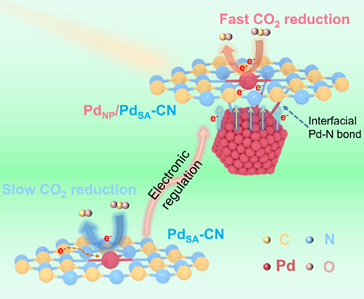Synergy palladium single atoms and twinned nanoparticles for efficient CO2 photoreduction
Published 04 March, 2024
The challenge to regulate the electronic structures of metal single-atoms (M-SAs) with metal twinned nanoparticles (M-TPs) lies in the synthesis of a definite architecture. Such a structure has strong electronic metal-support interactions and maintains electron transport channels to facilitate carbon dioxide photoreduction (CO2PR).
In a study published in the KeAi journal Advanced Powder Materials, a group of researchers from Zhejiang Normal University, Zhejiang A&F University and Dalian University of Technology, revealed the engineering of the electron density of Pd single atoms with twinned Pd nanoparticles assisted by strong electronic interaction of the atomic metal with the support and unveiled the underlying mechanism for expedited CO2PR.
"As one of the most promising CO2PR semiconductors, polymeric graphitic carbon nitride (g-C3N4) featured with sp2 π-conjugated lamellar structures can offer electronegative nitrogen atoms to anchor M-SAs, forming active metal-nitrogen moieties (M–Nx)," explained Lei Li, lead author of the study. "However, stable M–Nx configurations are not conducive to the tunability of electronic structures of M-SA sites.”
In particular, the extent of d-states of transition metals relative to Fermi level dictate metal–adsorbate binding strengths, which should be neither too weak nor too strong for the optimal catalytic activity. Thus, precise tailoring of electronic structures for metal centers is essential for efficient and selective CO2PR.
"Loading M-TPs on the hosts can be applied in modifying the metal single-sites without sacrificing pristine properties. Additionally, considering the high electron density of M-TPs, it is highly probable that charge density rearrangement occurs between M-SAs and M-TPs connected through ligand bridges," added Yong Hu, col-lead and co-corresponding author. "However, electronic interactions of M-SAs with M-TPs synchronously coordinated on g-C3N4 are rarely exploited in photocatalytic applications."
The researchers also found that the electronegative N sites in g-C3N4 bridged Pd-SAs and Pd-TPs, forming Pd–N bonds to create strong electronic metal-support interactions and permitting directional electron transport from Pd-TPs to Pd-SA sites for effective CO2PR. Both experimental and theoretical studies confirmed the multiple roles of Pd-TPs. The Pd-TPs served as an electron donator to enrich electron density on catalytic centers of single-Pd-sites through N ligands in g-C3N4 networks, thereby down-shifting the d-band center to accelerate carbonyl desorption for CO production.
The team’s findings offer a feasible approach to maneuver electronic structures of neighboring metal single sites by integrating M-TPs for photocatalysis.

Image: Schematic diagram of CO2 photoreduction mechanism. CREDIT: THE AUTHORS
Contact author details: Yong Hu, Key Laboratory of the Ministry of Education for Advanced Catalysis Materials, Department of Chemistry, Zhejiang Normal University, Jinhua, 321004, P. R. China; College of Chemistry and Materials Engineering, Zhejiang A&F University, Hangzhou, 311300, P. R. China.
Xi-Lin Wu, College of Geography and Environmental Science, Zhejiang Normal University, Jinhua, 321004, P. R. China.
Zhangrong Lou, Faculty of Medicine, Dalian University of Technology, Dalian, 116024, P. R. China.
yonghu@zjnu.edu.cn; yonghu@zafu.edu.cn (Yong Hu)
louzr@dlut.edu.cn (Zhangrong Lou)
dbwxl@zjnu.cn (Xi-Lin Wu).
Funder: This work was supported by the National Natural Science Foundation of China (22272150, 22102145), the Major Program of Zhejiang Provincial Natural Science Foundation (LD22B030002), Zhejiang Provincial Ten Thousand Talent Program (2021R51009), Zhejiang Provincial Natural Science Foundation of China (LQ23B030006, LY22B030012), Shandong Provincial Natural Science Foundation of China (2020MB053), and the Fundamental Research Funds for the Central Universities (DUT22RC(3)084).
Conflict of interest: The authors declare that they have no known competing financial interests or personal relationships that could have appeared to influence the work reported in this paper.
See the article: Lei, Li et al., Electron-enriched single-Pd-sites on g-C3N4 nanosheets achieved by in-situ anchoring twinned Pd nanoparticles for efficient CO2 photoreduction, Advanced Powder Materials, 3.2 (2024): 100170., https://doi.org/10.1016/j.apmate.2024.100170.

